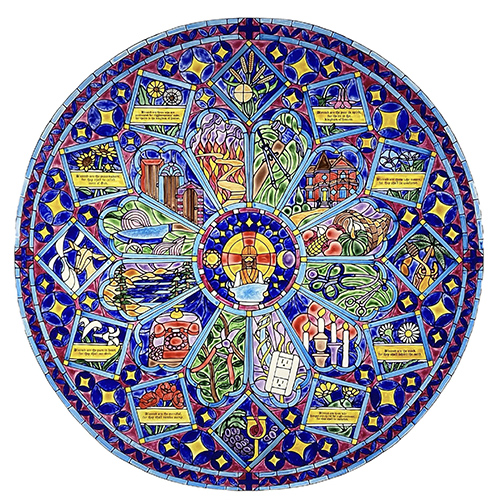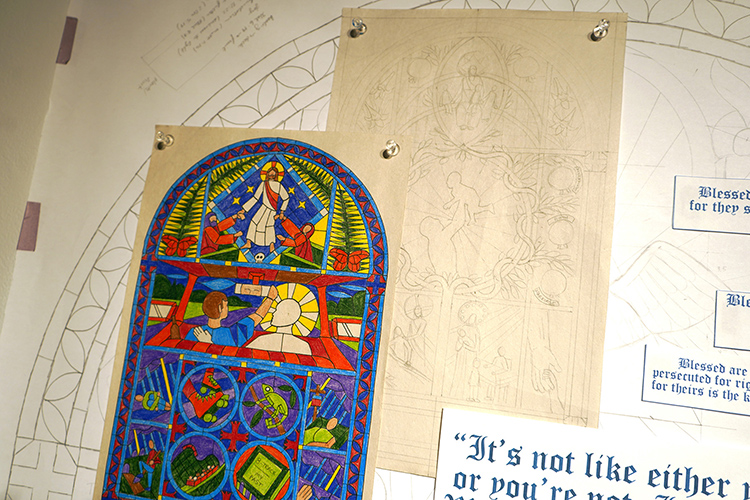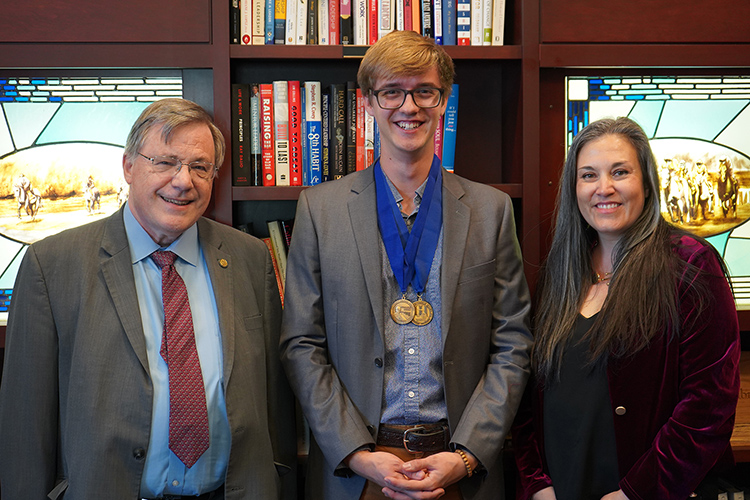Eli Ward, a religious studies and nursing double major with a love for art, combined all his passions to develop his Middle Tennessee State University Honors thesis, “Communicated Commemorabilia: A Creative Project Exploring Christian Recovery.”

A Murfreesboro, Tennessee, resident, Ward studies the intersections of health and faith and plans to pursue medical mission work. Additionally, his art has been published and received local and national awards.
“As a student of nursing and religious studies, I am interested in the convergence of religion and health,” said Ward, adding, “As an artist, I have represented this intersection in watercolor stained-glass windows.”

“When he first approached me with the idea of bringing his two fields of study — nursing and religious studies — together into a project that could be expressed in a creative, artistic form, I was thrilled,” said Rebekka King, Ward’s thesis director and professor of religious studies.
“His project is situated in a new and exciting field of study known as applied religious studies. This refers to coursework in the academic study of religion that extends beyond a traditional research paper to engage how religious people navigate the world and provide practical resources to community partners. Much of the innovative work in this field relates to health care, along with law, nonprofits, education, etc.”

Ward’s talents and scholarly interests led him to the creation of an immersive exhibit that was on display in a gallery at Todd Hall in Fall 2023 and reflected on the experiences of individuals in Christian addiction recovery groups. “Beyond the aesthetic beauty of stained glass, the medium has also captured sacred stories for centuries,” Ward states in his thesis pre-defense.

“These men and women are in pursuit of both their religion and their healing. As they heal, they tell stories of radical new identities, intimate communities, gradual change, empowering practices, and novel perceptions of God,” explained Ward in part of his thesis display. The project depicts sacred religious symbols in stories of healing.
Ward’s research process included conducting interviews with multiple participants at a local Christian recovery group.
“In recovery, they find physical and religious healing from addiction, trauma, and mental health alterations,” Ward said.
He discovered common themes from their shared stories. These themes are represented within the stained-glass-style works of art that he created in his exhibit. By painting on translucent paper, he was able to replicate a stained-glass appearance with lights behind hanging white sheets, imitating windows. Each piece of art conveys one of the five themes Ward identified in his interviewing process.
‘Moving’, ‘Thought-provoking’
Depictions on his artwork, such as an electrical outlet, or Jesus wearing a hardhat, may seem out of place in most traditional stained-glass works; however, every detail holds a deep meaning for the artist and for those he interviewed during his research. The outlet resonates particularly for one individual Ward interviewed who mentioned God’s power 12 times.
“She was adamant that the power of God was necessary for recovery and that it was too often neglected,” Ward recalled. So, the electrical outlet and the energy surging around it represent this power. This outlet is included in just one of 12 petals that make up a much larger image that Ward titled “The God Window.”

At its center of “The God Window” is Jesus wearing a hardhat. According to Ward, another interviewee spoke about God as a construction manager. “He’s in the construction business. He’s got the blueprints. And for him to refine us, it’s like remodeling. He’s got to tear down from the bottom up. And then mine and your job is to redecorate…” recalls Ward of the individual’s words.
Each depiction of a window is filled with symbolic details representing the emotional journeys Ward took with each of the individuals he interviewed. Part of the exhibit also displayed his artistic process and the development of each piece of art.
“He put hours of work into his institutional review board application and permissions, followed by formal interviews, transcriptions, and reflexive analysis. He then codified these interviews thematically and drew connections between his research and the prevailing themes about healing identified by anthropologists of Christianity,” explained King.
“This intertwining of image and narrative takes its most profound form in the icons and images of religious stained glass. I love how Eli’s project captures the ancient and the modern, the universal and the particular.”
Feedback from his exhibit has been overwhelmingly positive. While on display in the student gallery, he offered tours for anyone who wanted to learn more about his project and the stories of his interviewees.
“Several people have reached out to me to tell me how moving and thought-provoking they found his exhibit. This is what good art does — it creates an experience where we can reflect on ourselves, our relationships with others, and our place in the universe,” said King.
Ward said his thesis was dedicated to God, to those who work in healing, and to those in recovery. He successfully defended his Honors thesis on Nov. 6 and ceremoniously rang the Honors bells.
— Robin E. Lee (Robin.E.Lee@mtsu.edu)




COMMENTS ARE OFF THIS POST